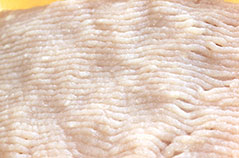
Ground Chicken
Ground chicken is boneless breast or thigh meat ground in a meat grinder or with the help of a chopping knife. Ground chicken is used as the main ingredient in a variety of popular dishes such as kofta kebabs and stuffed flat breads in Mediterranean, Middle Eastern, and South Asian cuisines. It is also used for making meatballs, patties for chicken sandwiches and burgers, stuffing for tacos, burritos, and quesadillas, and base of chili.
Ground chicken is easily available in grocery stores. Most of the grocery stores sell prepackaged ground chicken; however, some stores like Whole Foods also grind their chicken to order.
Ground chicken can be made at home with boneless and skinless chicken thigh or breast meat using the Pulse option of a food processor. Cut the chicken into one-inch cubes and pulse the pieces in small batches until coarsely minced.
Meat from chicken legs and thighs is dark in color and has more muscle and fat. Therefore, ground meat from legs or thighs is juicy and tender when roasted on high heat or slow cooked. On the other hand, chicken breast is white meat and is low in fat content; therefore, ground meat from chicken breast tends to dry out faster when cooked. Quickly cook chicken breast meat on high temperature by broiling, grilling, or pan searing. Slow cooking or cooking for even a few extra minutes will result in dry and chewy white meat.
Both dark and white chicken meat is a good source of proteins, vitamins A, K, B6, B12, folate, niacin, and minerals such as iron, selenium, phosphorus, and zinc.
Buy ground chicken with USDA organic seal to make sure that it is raised on food that does not contain animal by-products and is not raised with antibiotics.
Ground chicken is easily available in grocery stores. Most of the grocery stores sell prepackaged ground chicken; however, some stores like Whole Foods also grind their chicken to order.
Ground chicken can be made at home with boneless and skinless chicken thigh or breast meat using the Pulse option of a food processor. Cut the chicken into one-inch cubes and pulse the pieces in small batches until coarsely minced.
Meat from chicken legs and thighs is dark in color and has more muscle and fat. Therefore, ground meat from legs or thighs is juicy and tender when roasted on high heat or slow cooked. On the other hand, chicken breast is white meat and is low in fat content; therefore, ground meat from chicken breast tends to dry out faster when cooked. Quickly cook chicken breast meat on high temperature by broiling, grilling, or pan searing. Slow cooking or cooking for even a few extra minutes will result in dry and chewy white meat.
Both dark and white chicken meat is a good source of proteins, vitamins A, K, B6, B12, folate, niacin, and minerals such as iron, selenium, phosphorus, and zinc.
Buy ground chicken with USDA organic seal to make sure that it is raised on food that does not contain animal by-products and is not raised with antibiotics.
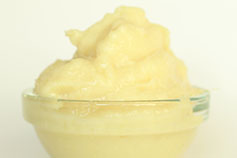
Ginger-Garlic Paste
Ginger-garlic paste is an important ingredient in Indian cooking. Most of the savory recipes in Indian cooking require ginger-garlic paste. You can either make the paste at home or buy it at an Indian or South Asian grocery store or gourmet markets.
The process of making ginger-garlic paste at home is very simple. All you need is peeled ginger and garlic in equal quantities and some olive oil (or any cooking oil of your choice).
To make 8 ounces (1 cup) of ginger-garlic paste, you’d need:
Ginger – 4 ounces (1/2 cup), peeled and cut into pieces
Garlic – 4 ounces (1/2 cup), peeled and cut into pieces
Olive oil – 1 tablespoon
Blend the ginger and garlic pieces with olive oil in a blender or a food processor. The oil will help ginger and garlic blend together. Store the paste in an airtight container and refrigerate it. It will stay fresh for 7-10 days.
In addition to enhancing the flavor and aroma of the food, ginger and garlic provide many health benefits if consumed on a regular basis. Both ginger and garlic have antioxidant and anti-inflammatory properties. Ginger has been proven to relieve a variety of ailments, such as gastrointestinal distress, motion sickness, arthritis, and cold and flu. Using garlic in food may help prevent many heart and blood system related conditions such as high blood pressure, high cholesterol, and coronary heart disease. Some researchers also claim that consumption of garlic on a regular basis reduces the risk of certain cancers such as stomach cancer, colon cancer, and lung cancer.
The process of making ginger-garlic paste at home is very simple. All you need is peeled ginger and garlic in equal quantities and some olive oil (or any cooking oil of your choice).
To make 8 ounces (1 cup) of ginger-garlic paste, you’d need:
Ginger – 4 ounces (1/2 cup), peeled and cut into pieces
Garlic – 4 ounces (1/2 cup), peeled and cut into pieces
Olive oil – 1 tablespoon
Blend the ginger and garlic pieces with olive oil in a blender or a food processor. The oil will help ginger and garlic blend together. Store the paste in an airtight container and refrigerate it. It will stay fresh for 7-10 days.
In addition to enhancing the flavor and aroma of the food, ginger and garlic provide many health benefits if consumed on a regular basis. Both ginger and garlic have antioxidant and anti-inflammatory properties. Ginger has been proven to relieve a variety of ailments, such as gastrointestinal distress, motion sickness, arthritis, and cold and flu. Using garlic in food may help prevent many heart and blood system related conditions such as high blood pressure, high cholesterol, and coronary heart disease. Some researchers also claim that consumption of garlic on a regular basis reduces the risk of certain cancers such as stomach cancer, colon cancer, and lung cancer.
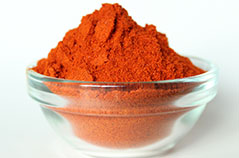
Red Chili Powder
Red chili powder is made by grinding dried deep red-brown thai chili peppers. Native to central and South America, red thai chili peppers were introduced to South Asia in 1500s and now India is the largest producer of these peppers in the world. Either in powdered or whole form, the chili peppers are used to add extra heat and spiciness to the dishes, which is due to the presence of a compound called capsaicin.
Red chili powder is a widely used spice for preparing a variety of curries, soups, stews, marinades, sauces, and dry rubs for barbecue. It is also used to flavor some sweet dishes such as cakes, brownies, truffles, and chocolates.
Red chili powder is a healthy seasoning. It contains significant amount of vitamin A and C, and beta carotenoids (a red-orange pigment that acts as an antioxidant and converts into vitamin A). It also helps to detoxify our body.
When purchasing red chili powder at store, look for the bright red colored powder for best taste. For making red chili powder at home:
Red chili powder is available in Indian and South Asian grocery stores. Some of the popular brands of red chili powder are Nirav, Deep, SWAD, Spicy World, and Everest. You may also find it in supermarkets or gourmet markets. It is available at online grocery stores such as amazon.com, where you will be able to choose from several brands.
Red chili powder is a widely used spice for preparing a variety of curries, soups, stews, marinades, sauces, and dry rubs for barbecue. It is also used to flavor some sweet dishes such as cakes, brownies, truffles, and chocolates.
Red chili powder is a healthy seasoning. It contains significant amount of vitamin A and C, and beta carotenoids (a red-orange pigment that acts as an antioxidant and converts into vitamin A). It also helps to detoxify our body.
When purchasing red chili powder at store, look for the bright red colored powder for best taste. For making red chili powder at home:
- Buy dry (not fresh) whole red thai chili peppers and remove the stems.
- Further dry the chili peppers in sun for a couple of days or slightly roast them for 2-3 minutes, without oil in a pan. Drying or roasting removes moisture from the chili peppers and adds extra crispness, which is required to powder them. Roasting the chili peppers enhances its flavor and aroma.
- Let the dried or roasted chili peppers cool down and then grind to a fine powder in a spice grinder. You can also use a coffee grinder for this purpose; however, the coffee grinder should be used for grinding spices only. It is not advisable to use the same grinder for spices and coffee.
Red chili powder is available in Indian and South Asian grocery stores. Some of the popular brands of red chili powder are Nirav, Deep, SWAD, Spicy World, and Everest. You may also find it in supermarkets or gourmet markets. It is available at online grocery stores such as amazon.com, where you will be able to choose from several brands.
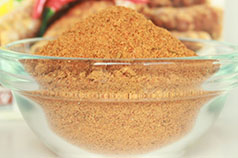
Kebab Masala (Optional)
Kebab masala is a special blend of spices and herbs that is basically used to marinate kebabs made with chunks of meat or vegetables or kofta kebabs made with ground meat or grated vegetables. It contains some basic spices found in every South Asian kitchen, such as coriander, cumin, and red chili powder as well as some ingredients that are not commonly used, such as dried papaya, soybean, pipli, mace, black cumin, ginger root, fennel, dried pomegranate, and the list goes on. These spices and herbs together create a very unique and concentrated flavor.
Most people use kebab masala in a small quantity, along with their own selected ingredients, to add extra flavor to the kebabs. Small quantities of kebab masala can also be added to soups, curries, and stews to enhance flavor and aroma.
You can buy kebab masala at Indian or South Asian grocery stores. The most popular brands of kebab masala are Shan and Laziza. It is also available at online grocery stores such as amazon.com.
Most people use kebab masala in a small quantity, along with their own selected ingredients, to add extra flavor to the kebabs. Small quantities of kebab masala can also be added to soups, curries, and stews to enhance flavor and aroma.
You can buy kebab masala at Indian or South Asian grocery stores. The most popular brands of kebab masala are Shan and Laziza. It is also available at online grocery stores such as amazon.com.
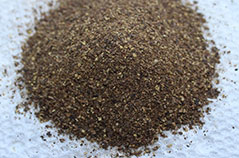
Black Pepper
Native to South India, black pepper, in whole or powdered or crushed form, is used as a spice or seasoning all over the world. In ancient times, black pepper was so expensive that it was used as a currency or collateral. Even today, black pepper is known as king of spices and is highly demanded spice around the world.
Black pepper powder is made by grinding the black peppercorns. Black peppercorns are made by picking the pepper berries when they are half ripe. Then they are dried in sun over a period of time, which causes them to shrivel and become dark in color. Because of their hard and shriveled texture, black peppercorns are easily ground in a pepper mill and taste best in this form. You can also powder the peppercorns by slightly roasting for 2-3 minutes and then grinding in a spice or coffee grinder (as always, do not use the same grinder for spices and coffee). As with all spices, roasting enhances the flavor of peppercorns. Buy peppercorns that are blemish free, heavy for their size, and compact.
Black pepper in any form is very flavorful and pungent and is used around the world to brighten the taste and aroma of a variety of dishes, from appetizers to desserts. In addition to enhancing the taste of food, it also acts as an appetite and taste buds stimulator and improves digestion. It acts as an antioxidant and is a good source of dietary fiber, vitamin K, and minerals such as iron and manganese.
Whole as well as ground/powdered black pepper is stored in air tight container in a cool, dark, and dry place. Black pepper powder can be stored at room temperature for 4-6 months while whole peppercorns last up to a year. You can also freeze them to last for up to 2 years.
Whole black peppercorns or powdered black pepper is available in any grocery store. You can also buy it at online grocery stores. My favorite is amazon.com. However, you can explore other online resource as well.
Black pepper powder is made by grinding the black peppercorns. Black peppercorns are made by picking the pepper berries when they are half ripe. Then they are dried in sun over a period of time, which causes them to shrivel and become dark in color. Because of their hard and shriveled texture, black peppercorns are easily ground in a pepper mill and taste best in this form. You can also powder the peppercorns by slightly roasting for 2-3 minutes and then grinding in a spice or coffee grinder (as always, do not use the same grinder for spices and coffee). As with all spices, roasting enhances the flavor of peppercorns. Buy peppercorns that are blemish free, heavy for their size, and compact.
Black pepper in any form is very flavorful and pungent and is used around the world to brighten the taste and aroma of a variety of dishes, from appetizers to desserts. In addition to enhancing the taste of food, it also acts as an appetite and taste buds stimulator and improves digestion. It acts as an antioxidant and is a good source of dietary fiber, vitamin K, and minerals such as iron and manganese.
Whole as well as ground/powdered black pepper is stored in air tight container in a cool, dark, and dry place. Black pepper powder can be stored at room temperature for 4-6 months while whole peppercorns last up to a year. You can also freeze them to last for up to 2 years.
Whole black peppercorns or powdered black pepper is available in any grocery store. You can also buy it at online grocery stores. My favorite is amazon.com. However, you can explore other online resource as well.
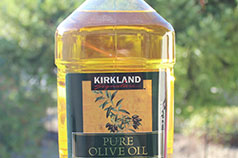
Olive Oil
Olive is one of the oldest known cultivated trees in the world. It is said that Olive trees are being cultivated before the invention of written language. Olive trees are draught tolerant and are native to eastern Mediterranean region. The trees can survive and bear fruits for a thousand year. Olives are small fruits of the Olive tree. During prehistoric time, people use to grind and drain the pulp of olives to get oil for cooking and lighting lamps. Oil extracted from olives was also used for cosmetic purposes.
Today, olive oil is popular than any other oil for culinary use and health benefits. About 90% of the olive fruit produce goes toward the production of olive oil. The oil is produced by pressing the whole olives and is used for cooking, cosmetics, pharmaceutical uses, and as fuel for certain lamps.
Olive oil used for cooking and eating is broadly classified as extra virgin, virgin, pure, and light. The difference is mainly in the process of production of different verities, due to which they contain different levels of antioxidant and have different smoking point.
Extra virgin olive oil is the best quality and is extracted using mechanical process such as cold pressing and centrifugation. The olives are pressed at normal temperature without the use of heating and chemicals. This method of extraction helps preserve most of the antioxidants and hence, makes the oil of high quality. The extra virgin olive oil smokes at a very low temperatures ranging from 200 to 372 degree Fahrenheit depending upon the quality (the better the quality have higher smoking point). Therefore, extra virgin olive oil is considered cold dishes like salad dressing and dips as well as cooking at a medium heat. You can use the good quality extra virgin oil to sauté vegetables, shallow frying eggs, and meats. It’s not recommended to use extra virgin olive oil for deep frying at higher temperatures.
Virgin olive oil is extracted using the same process as extra virgin. It has same levels of monounsaturated fats, antioxidant, and has the similar smoking point. It’s different from extra virgin because it’s made using relatively ripe olives, which gives it light flavor. The usage of virgin oil for cooking is same as extra virgin oil.
Pure olive oil has the same monounsaturated fat content, but has less antioxidant. Pure olive oil, also called olive oil, is a blend of virgin oil and refined pomace oil (also called refined olive oil). Pomace oil, a leftover during the extraction of extra virgin and virgin oils, is refined before mixing it to the virgin oil. The blend contains only about 5 to 10% of virgin oil. It’s lighter in taste, and has higher smoking point that makes it fit for sautéing and frying.
Light olive oil has the same percentage of monounsaturated fat, but lowest level of antioxidants. It’s basically refined olive oil, manufactured by the using some chemical and heat to get rid of impurities. It’s smoking point is highest and is ideal for high temperature cooking, such as deep frying and baking.
At higher temperatures, required for deep frying, extra virgin and virgin oil lose their antioxidant properties and flavor. Therefore, many cooks use pure or light olive oil for frying. Some views suggest that cooking with extra virgin and virgin olive oil at high temperatures is harmful for health; however, there is no substantial evidence to support such views. This might be a myth or a truth. Therefore, to be on the safe side, it’s advisable to use pure and light olive oil for higher temperature cooking such as deep frying, and use good quality extra virgin and virgin olive oil for cold dishes and cooking at medium temperature such as sautéing.
Because of the higher monounsaturated fat content, all kinds of olive oil lasts longer than other oils. After opening, close the cap or lid completely and store in a cool, dark, and dry place, and use it within 3 – 4 months from opening. Due to the presence of antioxidant substances, extra virgin and virgin oils are more resistant to damage by oxygen in air. However, the chlorophyll in the oil makes them vulnerable to damage by light. Therefore, always store the extra virgin and virgin oil in a dark place away from light. Refrigeration slightly solidifies the oil, which comes back to its liquid state when kept at room temperature, but will lose its flavor.
Olive oil has high content of antioxidants called polyphenols, carotenoids, and tocopherols. It’s high in monounsaturated fat and has low saturated and polyunsaturated fat. This composition makes it healthy for heart and for prevention of many medical conditions like, cancer, high blood pressure, and diabetes. According to some recent research, consumption of olive oil improves calcium absorption; hence, prevents the onset osteoporosis.
You can buy olive oil at any grocery store. It is available at online grocery stores such as www.amazon.com. Type the kind of olive oil you want to buy on search bar, you will be able to choose from several options.
Today, olive oil is popular than any other oil for culinary use and health benefits. About 90% of the olive fruit produce goes toward the production of olive oil. The oil is produced by pressing the whole olives and is used for cooking, cosmetics, pharmaceutical uses, and as fuel for certain lamps.
Olive oil used for cooking and eating is broadly classified as extra virgin, virgin, pure, and light. The difference is mainly in the process of production of different verities, due to which they contain different levels of antioxidant and have different smoking point.
Extra virgin olive oil is the best quality and is extracted using mechanical process such as cold pressing and centrifugation. The olives are pressed at normal temperature without the use of heating and chemicals. This method of extraction helps preserve most of the antioxidants and hence, makes the oil of high quality. The extra virgin olive oil smokes at a very low temperatures ranging from 200 to 372 degree Fahrenheit depending upon the quality (the better the quality have higher smoking point). Therefore, extra virgin olive oil is considered cold dishes like salad dressing and dips as well as cooking at a medium heat. You can use the good quality extra virgin oil to sauté vegetables, shallow frying eggs, and meats. It’s not recommended to use extra virgin olive oil for deep frying at higher temperatures.
Virgin olive oil is extracted using the same process as extra virgin. It has same levels of monounsaturated fats, antioxidant, and has the similar smoking point. It’s different from extra virgin because it’s made using relatively ripe olives, which gives it light flavor. The usage of virgin oil for cooking is same as extra virgin oil.
Pure olive oil has the same monounsaturated fat content, but has less antioxidant. Pure olive oil, also called olive oil, is a blend of virgin oil and refined pomace oil (also called refined olive oil). Pomace oil, a leftover during the extraction of extra virgin and virgin oils, is refined before mixing it to the virgin oil. The blend contains only about 5 to 10% of virgin oil. It’s lighter in taste, and has higher smoking point that makes it fit for sautéing and frying.
Light olive oil has the same percentage of monounsaturated fat, but lowest level of antioxidants. It’s basically refined olive oil, manufactured by the using some chemical and heat to get rid of impurities. It’s smoking point is highest and is ideal for high temperature cooking, such as deep frying and baking.
At higher temperatures, required for deep frying, extra virgin and virgin oil lose their antioxidant properties and flavor. Therefore, many cooks use pure or light olive oil for frying. Some views suggest that cooking with extra virgin and virgin olive oil at high temperatures is harmful for health; however, there is no substantial evidence to support such views. This might be a myth or a truth. Therefore, to be on the safe side, it’s advisable to use pure and light olive oil for higher temperature cooking such as deep frying, and use good quality extra virgin and virgin olive oil for cold dishes and cooking at medium temperature such as sautéing.
Because of the higher monounsaturated fat content, all kinds of olive oil lasts longer than other oils. After opening, close the cap or lid completely and store in a cool, dark, and dry place, and use it within 3 – 4 months from opening. Due to the presence of antioxidant substances, extra virgin and virgin oils are more resistant to damage by oxygen in air. However, the chlorophyll in the oil makes them vulnerable to damage by light. Therefore, always store the extra virgin and virgin oil in a dark place away from light. Refrigeration slightly solidifies the oil, which comes back to its liquid state when kept at room temperature, but will lose its flavor.
Olive oil has high content of antioxidants called polyphenols, carotenoids, and tocopherols. It’s high in monounsaturated fat and has low saturated and polyunsaturated fat. This composition makes it healthy for heart and for prevention of many medical conditions like, cancer, high blood pressure, and diabetes. According to some recent research, consumption of olive oil improves calcium absorption; hence, prevents the onset osteoporosis.
You can buy olive oil at any grocery store. It is available at online grocery stores such as www.amazon.com. Type the kind of olive oil you want to buy on search bar, you will be able to choose from several options.

Salt
Salt is a mineral composed of a chemical compound called sodium chloride. It is essential for human body to regulate fluid balance and to control function of nerves and muscles. Human body cannot produce its own salt and depends on various sources of salt in food for necessary daily intake.
In addition to being just a diet supplement, salt helps in extracting the real flavors of savory as well as sweet dishes. No other seasoning has been found so fulfilling to replace salt. However, the overuse of salt results into a lot of health problems, such as hypertension, heart disease, and strokes. Use salt mildly in your food to you can enjoy its goodness.
In addition to being just a diet supplement, salt helps in extracting the real flavors of savory as well as sweet dishes. No other seasoning has been found so fulfilling to replace salt. However, the overuse of salt results into a lot of health problems, such as hypertension, heart disease, and strokes. Use salt mildly in your food to you can enjoy its goodness.

Onion
Most researchers agree that onion has been cultivated for 5000 years or more, and they were first grown in central Asia. Others suggest that onions were first grown in Iran and western Pakistan. Onions can be grown in a variety of soils and climates and are less perishable; therefore, it is believed that they were domesticated simultaneously all over the world. It is interesting to know that Egyptians worshiped onions and believed that concentric rings of onions symbolize eternal life.
Due to pungent taste and smell, humans started onions to protect their plants from animals and insects. The strong flavor of onions comes from sulphur compounds, which onion plants absorb from soil when growing. When an onion is cut, certain enzyme breaks out producing strong sulphurous smell.
Cooking alters the strong and pungent taste of onions into meaty taste that adds flavor to various dishes in many cultures. Onions are also eaten in raw form to garnish many dishes. Cut onions can be rinsed properly to remove sulphur, when eaten raw. You can also put the onions in the freezer for 20-30 minutes to minimize the release of sulphurous smell and taste.
The sulphur compounds, flavonoids (antioxidants), and fructans (small carbohydrate molecules) help prevent cancer, stomach ulcer, and reduce symptoms of diabetes mellitus.
Whole dry onions should be stored at room temperature at dry place with proper ventilation. Do not store onions in closed plastic bags. Netted or punched bags are best to store whole onions for better ventilation, and last upto 4 weeks. Cut onions needs to be refrigerated. Cut onions stored in a sealed container can last up to a week.
Due to pungent taste and smell, humans started onions to protect their plants from animals and insects. The strong flavor of onions comes from sulphur compounds, which onion plants absorb from soil when growing. When an onion is cut, certain enzyme breaks out producing strong sulphurous smell.
Cooking alters the strong and pungent taste of onions into meaty taste that adds flavor to various dishes in many cultures. Onions are also eaten in raw form to garnish many dishes. Cut onions can be rinsed properly to remove sulphur, when eaten raw. You can also put the onions in the freezer for 20-30 minutes to minimize the release of sulphurous smell and taste.
The sulphur compounds, flavonoids (antioxidants), and fructans (small carbohydrate molecules) help prevent cancer, stomach ulcer, and reduce symptoms of diabetes mellitus.
Whole dry onions should be stored at room temperature at dry place with proper ventilation. Do not store onions in closed plastic bags. Netted or punched bags are best to store whole onions for better ventilation, and last upto 4 weeks. Cut onions needs to be refrigerated. Cut onions stored in a sealed container can last up to a week.
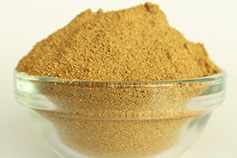
Coriander Powder
Coriander, also known as cilantro and Chinese parsley, is an herb native to Southeastern Europe and is cultivated in Egypt, Middle East, China, India, and Turkey. Coriander powder is made by grinding the dried or roasted seeds of coriander plant. The seeds are small (2-3 mm long), oval in shape, and light brown in color. Coriander powder provides mild-nutty flavor and aroma to many savory and sweet dishes.
Due to its mild-nutty taste and aroma, coriander powder is an essential ingredient in many vegetable and meat curry preparations and barbecue rubs and sauces. It is also added to waffle and pancake mixes and dessert sauces for an enhanced taste.
The presence of coriander powder in food stimulates the taste buds and helps digestion. Including coriander in your diet has many health benefits. It is a great source of potassium, iron, vitamin A, K and C, folic acid, magnesium, and calcium. It is a good source of antioxidants and helps detoxify the body.
Coriander powder is easily available in grocery stores or can be made at home by grinding the coriander seeds. To make coriander powder at home:
Due to its mild-nutty taste and aroma, coriander powder is an essential ingredient in many vegetable and meat curry preparations and barbecue rubs and sauces. It is also added to waffle and pancake mixes and dessert sauces for an enhanced taste.
The presence of coriander powder in food stimulates the taste buds and helps digestion. Including coriander in your diet has many health benefits. It is a great source of potassium, iron, vitamin A, K and C, folic acid, magnesium, and calcium. It is a good source of antioxidants and helps detoxify the body.
Coriander powder is easily available in grocery stores or can be made at home by grinding the coriander seeds. To make coriander powder at home:
- Either dry the coriander seeds in sun for a couple of days or slightly roast the seeds without oil in a pan. Roasting the seeds before grinding enhances the taste and aroma of the coriander powder. Also, drying in sun or roasting removes moisture from the seeds and adds crispness, which helps in powdering the seeds.
- Let the seeds cool and then grind them in a spice grinder. You can also use a coffee grinder for grinding spices; however it’s not recommended to use the same grinder for grinding spices and coffee.
- Store coriander powder in a tightly sealed container in a cool, dark, and dry place. If you are making coriander powder at home, cool it down before storing. It usually last for 4-6 months at room temperature. Refrigerate it for a longer shelf life of 18-24 months.
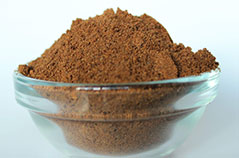
Garam Masala Powder
An authentic garam masala is a collection of four spices either in whole or powdered form. The four spices, green cardamom, black cardamom, clove, and cinnamon stick added in the right proportion enhances the flavor and aroma of the dishes. The word ‘garam’ means warm or hot and ‘masala’ means spice; however, garam masala does not mean that the spices are hot. It means that the spices raise your body temperature by increasing the metabolism. The taste of garam masala in food is intense (not hot) yet pleasant.
Either in whole or powdered form, it is an essential ingredient in many Indian and South Asian cuisine. The whole garam masala is usually added to the hot oil before other ingredients to release its flavor to the oil. On the other hand, the garam masala powder is added to the dishes with other powdered spices while cooking or just for seasoning the dishes toward the end of the cooking. Garam masala is used to flavor a variety of curries, stews, and soups and marinades and rubs for barbecue. Green cardamom, cinnamon, and clove are used to flavor a wide range of desserts.
Readymade garam masala powder is available in Indian or South Asian grocery stores or gourmet markets. However, the readymade masala contains several ingredients in addition to the four basic spices, which makes it not taste exactly like the authentic garam masala. I have tried it once and decided to make my own at home. It tastes good, but does not taste like real garam masala. However, you can go ahead and try to see if you like it.
There are two methods to make garam masala powder at home:
Method 1:
Most grocery stores that sell Indian or South Asian spices, also sell powdered green cardamom, cinnamon, and clove individually in small packets. Go ahead and buy the spices powder and mix them at home in the proportion listed below:
Black Cardamom Powder - 2 tablespoon
Cinnamon Powder – 1 tablespoon
Green Cardamom Powder – 1/2 tablespoon
Clove Powder – 1/2 tablespoon
The above ingredients mixed together will make ½ cup (4 ounces) garam masala powder.
Method 2:
This is the tradition method of making garam masala at home by roasting and grinding the whole garam masala as follows:
Whole black cardamom pods – 6 (Use whole, not shelled)
Whole cinnamon sticks – 5 (3 inches long)
Whole green cardamom pods – 10 (Use whole, not shelled)
Whole cloves - 12
Since we are using whole cardamom pods with shell, the above ingredients together after grinding will make a little more than ½ cup garam masala powder.
Slightly roast or warm the above listed whole spices for about 2-3 minutes and let it cool. Then grind them together in a spice grinder or a coffee grinder designated for grinding spices only. Roasting or warming the spices adds crispness and intensifies the flavor and aroma of the spices. Cool the powdered garam masala before storing.
Store the masala powder in a tight lid jar in a cool, dark, and dry place. It will last for about six months at room temperature. If you do not use it often in your cooking then keep it in the freezer to last up to 2 years.
In addition to the adding wonderful flavor and aroma to the food, garam masala helps in boosting metabolism and promoting weight loss. It helps in absorbing nutrients and lowering blood sugar. It also helps in detoxification.
You can buy whole or powdered garam masala at any Indian or South Asian grocery store or gourmet markets. It is available at online grocery stores such as amazon.com. Type the name of garam masala spice you want to buy on search bar, you will be able to choose from several brands.
Either in whole or powdered form, it is an essential ingredient in many Indian and South Asian cuisine. The whole garam masala is usually added to the hot oil before other ingredients to release its flavor to the oil. On the other hand, the garam masala powder is added to the dishes with other powdered spices while cooking or just for seasoning the dishes toward the end of the cooking. Garam masala is used to flavor a variety of curries, stews, and soups and marinades and rubs for barbecue. Green cardamom, cinnamon, and clove are used to flavor a wide range of desserts.
Readymade garam masala powder is available in Indian or South Asian grocery stores or gourmet markets. However, the readymade masala contains several ingredients in addition to the four basic spices, which makes it not taste exactly like the authentic garam masala. I have tried it once and decided to make my own at home. It tastes good, but does not taste like real garam masala. However, you can go ahead and try to see if you like it.
There are two methods to make garam masala powder at home:
Method 1:
Most grocery stores that sell Indian or South Asian spices, also sell powdered green cardamom, cinnamon, and clove individually in small packets. Go ahead and buy the spices powder and mix them at home in the proportion listed below:
Black Cardamom Powder - 2 tablespoon
Cinnamon Powder – 1 tablespoon
Green Cardamom Powder – 1/2 tablespoon
Clove Powder – 1/2 tablespoon
The above ingredients mixed together will make ½ cup (4 ounces) garam masala powder.
Method 2:
This is the tradition method of making garam masala at home by roasting and grinding the whole garam masala as follows:
Whole black cardamom pods – 6 (Use whole, not shelled)
Whole cinnamon sticks – 5 (3 inches long)
Whole green cardamom pods – 10 (Use whole, not shelled)
Whole cloves - 12
Since we are using whole cardamom pods with shell, the above ingredients together after grinding will make a little more than ½ cup garam masala powder.
Slightly roast or warm the above listed whole spices for about 2-3 minutes and let it cool. Then grind them together in a spice grinder or a coffee grinder designated for grinding spices only. Roasting or warming the spices adds crispness and intensifies the flavor and aroma of the spices. Cool the powdered garam masala before storing.
Store the masala powder in a tight lid jar in a cool, dark, and dry place. It will last for about six months at room temperature. If you do not use it often in your cooking then keep it in the freezer to last up to 2 years.
In addition to the adding wonderful flavor and aroma to the food, garam masala helps in boosting metabolism and promoting weight loss. It helps in absorbing nutrients and lowering blood sugar. It also helps in detoxification.
You can buy whole or powdered garam masala at any Indian or South Asian grocery store or gourmet markets. It is available at online grocery stores such as amazon.com. Type the name of garam masala spice you want to buy on search bar, you will be able to choose from several brands.

Cilantro
Cilantro is the leaves and stem of coriander plant native to Southeastern Europe and is cultivated in Egypt, Middle East, China, India, and Turkey. It is also called coriander and Chinese parsley. You must know that cilantro (leaves and stems) and coriander seed/powder come from same plant, but they have very different flavor and cannot be substituted for each other.
Cilantro is widely used in Asian, Mexican, Latin American, and Caribbean cooking. It is mostly used to season savory and highly spicy dishes. It is either added to the dishes while they are cooking or just topped on the dishes for presentation. You can also add chopped cilantro to salads or dips.
The deep green cilantro leaves contains significant amount of antioxidants and essential oils, dietary fiber, and vitamins A, C, beta carotene, and K. It is also a good source of minerals, such as iron, potassium, and calcium. One teaspoon of green chutney made with cilantro provides daily value of iron intake. It also helps in detoxification.
Cilantro is also said to be a natural preservative, because it slows down the oxidation process and spoilage of food in which it is added. The leaves are also antibacterial in nature.
Cilantro is sold in bunches and can be found year-round in most of the grocery stores. A good quality cilantro is bright green and not wilted or drooped by loosing moisture. Store cilantro in a plastic bag in the crisper section of your refrigerator.
Cilantro is widely used in Asian, Mexican, Latin American, and Caribbean cooking. It is mostly used to season savory and highly spicy dishes. It is either added to the dishes while they are cooking or just topped on the dishes for presentation. You can also add chopped cilantro to salads or dips.
The deep green cilantro leaves contains significant amount of antioxidants and essential oils, dietary fiber, and vitamins A, C, beta carotene, and K. It is also a good source of minerals, such as iron, potassium, and calcium. One teaspoon of green chutney made with cilantro provides daily value of iron intake. It also helps in detoxification.
Cilantro is also said to be a natural preservative, because it slows down the oxidation process and spoilage of food in which it is added. The leaves are also antibacterial in nature.
Cilantro is sold in bunches and can be found year-round in most of the grocery stores. A good quality cilantro is bright green and not wilted or drooped by loosing moisture. Store cilantro in a plastic bag in the crisper section of your refrigerator.
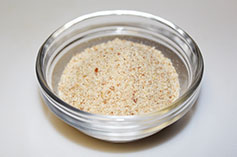
Breadcrumb
Breadcrumbs are small particles made by grating or coarsely grinding bread slices. They are used in a versatile ways in cooking, such as binding meatballs and kofta kebabs, thickening sauces, stuffing poultry, topping casseroles, and coating meats, fish, and vegetables for frying. Breadcrumbs adds volume and provides crispy and crunchy texture or coating to the dishes.
Breadcrumbs can be dry or fresh, based on the way they are made. Dry breadcrumbs are easily available in a number of brands in grocery stores and supermarkets. However, to make dry bread crumbs at home:
- Remove the crust of bread slices and spread them in a single layer on a baking sheet.
- Bake them in an oven at 350 degree Fahrenheit to remove moisture. Turn it over a few times to be baked on both sides.
- Remove from the oven when they turn light brown, dry and crispy.
- Let them cool down and then grate them or process in a food processor using a steel blade to make coarse crumbs. You can also season the dry bread crumbs by adding garlic powder, lemon jest, crushed pepper flakes, or herbs.
Fresh breadcrumbs are made at home by breaking the bread slices into small pieces and process in a food processor or a blender until they make coarse crumbs.
You can buy dry breadcrumbs at grocery stores and supermarkets, or buy them online at amazon.com. However, you can explore other online resources as well.
Breadcrumbs can be dry or fresh, based on the way they are made. Dry breadcrumbs are easily available in a number of brands in grocery stores and supermarkets. However, to make dry bread crumbs at home:
- Remove the crust of bread slices and spread them in a single layer on a baking sheet.
- Bake them in an oven at 350 degree Fahrenheit to remove moisture. Turn it over a few times to be baked on both sides.
- Remove from the oven when they turn light brown, dry and crispy.
- Let them cool down and then grate them or process in a food processor using a steel blade to make coarse crumbs. You can also season the dry bread crumbs by adding garlic powder, lemon jest, crushed pepper flakes, or herbs.
Fresh breadcrumbs are made at home by breaking the bread slices into small pieces and process in a food processor or a blender until they make coarse crumbs.
You can buy dry breadcrumbs at grocery stores and supermarkets, or buy them online at amazon.com. However, you can explore other online resources as well.

Lime Juice
Lime juice or juice extracted from lime is a great source of vitamin C and used to add tartness and freshness to food and beverages. It also a natural preservative and slows down the spoilage of food. The juice is squeezed from fresh cut lime or bought readymade at grocery stores or supermarkets.
Best quality lime is bright deep green in color and is firm and heavy for its size. More ripen lime turn yellow in color; however it is best when green. Lime produces more juice when warmer. Therefore, to get the most juice out of lime, bring it to room temperature (if refrigerated) and roll it under your palm against a hard surface to warm it more, before squeezing. Another quick method is to microwave it for 15-30 seconds, let it sit for a few minutes before cutting and squeezing.
In addition to its use in food and drinks, lime juice also provides health benefits that include weight loss, skin care, and improved digestion. Due to the presence of significant amount of vitamin C, it helps in curing scurvy, which is caused due to vitamin C deficiency. Vitamin C in lime juice also acts as an antioxidant and helps in strengthening the immune system.
Lime or packaged lime juice is available in grocery stores throughout the year. Lime will stay fresh for a week at room temperature when kept away from sunlight. You can also store it in your refrigerator’s crisper tray for about a month, if bought fresh.
Best quality lime is bright deep green in color and is firm and heavy for its size. More ripen lime turn yellow in color; however it is best when green. Lime produces more juice when warmer. Therefore, to get the most juice out of lime, bring it to room temperature (if refrigerated) and roll it under your palm against a hard surface to warm it more, before squeezing. Another quick method is to microwave it for 15-30 seconds, let it sit for a few minutes before cutting and squeezing.
In addition to its use in food and drinks, lime juice also provides health benefits that include weight loss, skin care, and improved digestion. Due to the presence of significant amount of vitamin C, it helps in curing scurvy, which is caused due to vitamin C deficiency. Vitamin C in lime juice also acts as an antioxidant and helps in strengthening the immune system.
Lime or packaged lime juice is available in grocery stores throughout the year. Lime will stay fresh for a week at room temperature when kept away from sunlight. You can also store it in your refrigerator’s crisper tray for about a month, if bought fresh.
Share your thoughts and questions!


